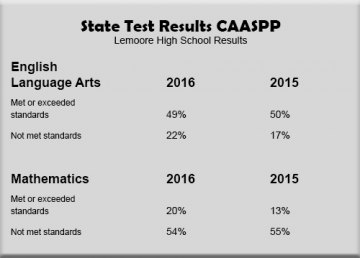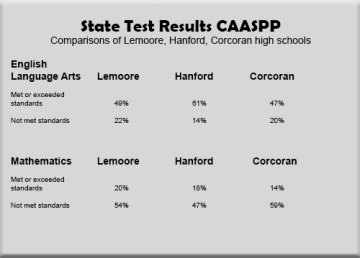Smarter Balanced, Common Core and the struggle to improve student learning

California’s students have been down this road before, a path littered with a myriad of past reforms: CSTs (California Standards Test), API (Academic Performance Index), the High School Exit Exam, No Child Left Behind, and other so-called reform measures that have literally disappeared beneath a mountain of high expectations, and now, an increasing array of students, more interested in social media than “Huckleberry Finn,” are being challenged by the latest measurement tool: Smarter Balanced Assessments, a new series of exams based on the Common Core Standards.
The infamous CAHSEE (California High School Exit Exam) was relegated to the trash heap just this past year – technically just a suspension, but it’s unclear if it will ever make a return engagement in California.
On Aug. 24, California’s school districts got their most recent results from last spring’s latest tool to measure the academic performance of California’s millions of students – the Smarter Balanced Assessments, a statewide system of computer-based tests that measure student knowledge of California’s English language arts and mathematics standards. These tests replaced the old No. 2 pencil and paper scantron tests, used for decades in public education, frustrating millions of school-age kids, but also kept the pencil manufacturers in business.

The latest round of test results was released Wednesday and State Superintendent of Public Instruction Tom Torlakson indicated that California students made significant progress in the second year of the California Student Performance and Progress (CAASPP) online tests, as he said students met or exceeded standards in every grade and in every student group.
Some may have increased more than others. Torlakson was predictably upbeat about the results. “The higher test scores show that the dedication, hard work, and patience of California’s teachers, parents, school employees, and administrators are paying off,” he said in a press release announcing the release of the test results. “Together we are making progress towards upgrading our educational system to prepare all students for careers and college in the 21st century.”
Lemoore High School, State of California Comparison
Search Smarter Balanced Test Results at California Dept. of Education
Statewide, approximately 3.2 million students, grade 3 through 8 and grade 11, completed the computerized exams in math and English.
In Lemoore, 482 juniors, 440 of them at Lemoore High School, 50 at Middle College High School, and 42 at Jamison High took the test last spring.
School officials like Torlakson and local educators tried to paint a pretty picture. “Although Lemoore High School District overall has not performed as well as the state average, we are on par or exceeding our county counterparts,” said Lemoore High School District Assistant Superintendent Victor Rosa. “Math continues to be a major struggle for both our district and the majority of Central Valley high schools. The reality is that statewide, performance on the math CAASPP was pretty low.”
Achievement in math continues to be an issue for Lemoore’s students as well, said Rosa. “Much of this is due to the overhaul from old math standards into the new Common Core,” he said. “Although we are confident that over time, students will benefit from these new standards, the students tested last year, and the next several years, spent many years of instruction in the old standards and only a couple in the new.”
Despite the upbeat announcement by Torlakson and other school officials, Lemoore High School’s results were mixed as Lemoore 11th graders failed to match the statewide standards in English, and continued their longtime struggle with math.
Statewide, 59 percent of students met or surpassed English standards, and only 33 percent of students met or exceeded math standards.
This latest round of tests is the second year that Smarter Balanced tests have been given to California students. And it probably won’t be the last, until of course that time comes when Californians decided on a new test – because they didn’t like the latest one.
The first Smarter Balanced tests took place in 2015. The new tests are part of a new testing program called the California Assessment of Student Performance and Progress (CAASPP).
Smarter Balanced tests consist of two parts. Initially, students take a computer adaptive assessment, which bases follow-up questions on a student's answers in real time and gives a more accurate picture of a student's progress than the paper and pencil test.
Here's basically how it works: If a student answers a question correctly, he or she earns a more difficult question. If the student answers it incorrectly, he or she then gets an easier question.
Students also complete a performance task that challenges their ability to apply their knowledge and skills to problems in a real-world setting. The two parts measure depth of understanding, writing, research and problem-solving skills more thoroughly than the multiple-choice, paper-based tests they replaced.
Whether these new tests will result in better data or results from Lemoore area students, remains to be seen, but based on the most recent test scores, students in Lemoore have a way to go, particularly in mathematics.
“To help improve math scores, we have invested in new curriculum and increased professional development for our teachers,” said Rosa. “Much more project-based learning is occurring in math classrooms which better aligns with the Common Core and allows students to apply the math they are learning and better articulate how math can be used in practical applications.”
Statewide and school results can be interpreted in a myriad of ways. A school’s ability to exceed standards often is dependent on the diversity and location of a school. The Los Angeles Times suggests that the state’s best performing schools come from wealthy enclaves like Montecito, San Marino or Orinda, a wealthy community in the East Bay of San Francisco where students routinely score high on state tests and 98 percent of grads enroll in college.
Lemoore High’s students came in below the state as 49 percent of students met or exceeded the standards in English/Language Arts. As indicated earlier, 59 percent of California 11th graders met or exceeded the standards in English/Language Arts.
However, a much different result occurred in math as 54 percent of Lemoore’s students failed to meet the state’s standard, and only 20 percent of LHS students met or exceeded the CAASPP standards in math. Only 5 percent of Lemoore High’s students strictly exceeded the state’s standard. Statewide results reveal that 33 percent of 11th grade students met or exceeded the standards while just 13 percent strictly exceeded the math standards.
It is a much different story at the Lemoore district’s Middle College High School, a charter school housed on the West Hills College, Lemoore campus. The school caters to high academic performers and houses about 250 students. Students performed remarkably well, meeting or exceeding the state standards at 68 percent in English and 44 percent in math.
Middle College students have an opportunity to take college and high school classes in an effort to attain an associate’s degree as well as high school diploma during their four years of high school.
At the Lemoore Elementary School District, local students mirrored the state’s results. Both statewide elementary students and Lemoore kids did not meet math standards 35 percent of the time, but local students did meet or exceed English standards at 48 percent compared to a statewide percentage of 49 percent.
In Kings County, Hanford High School, Lemoore, and Corcoran earned relatively similar results in math and English. While Lemoore students met and exceeded the math standards at 20 percent, Hanford met or exceeded the standards to the tune of 18 percent. Corcoran checked in with 14 percent students meeting or exceeding the state standards.
“The bright spot in all of this is that Lemoore High School District chose to take on the transition to Common Core early, and we are therefore more experienced and entrenched than many other schools across the state that waited,” stated an upbeat Rosa. “Although we are still in a period of transition, we are confident that we will continue to improve our results.”
Join the discussion at the bottom of this page ...
Education
- Lemoore Union Elementary School District seeks trustee to serve on local school board
- Local elections in Lemoore Elementary District and Lemoore High School finalized for November
- Lemoore students return to schools this week that will not require masks, but they remain optional for those who want them
- Packed house delivers kudos at West Hills College Lemoore graduation
- West Hills College Lemoore earns kudos from Fresno Bee's Best of Central California People's Choice
- Lemoore's Middle College High School ranks high once again at Academic Decathlon Nationals
_0.jpg)

.jpg)




